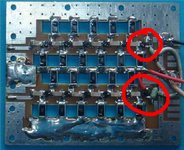ghost896
Junior Member level 3
Hello everyone, I am researching on an avalanche based circuit with symmetric output. I have general information about avalanche transistors and how the marx generator works, but there are some parts that I do not understand in the circuit I shared.
The article mentioned that T1 changes the trigger voltage in positive and negative directions. I don't understand how this change happens. In this way, it puts the avalanche transistors in the upper and lower chains into avalanche mode.
Does anyone have a better explanation or understanding of the circuit?


The article mentioned that T1 changes the trigger voltage in positive and negative directions. I don't understand how this change happens. In this way, it puts the avalanche transistors in the upper and lower chains into avalanche mode.
Does anyone have a better explanation or understanding of the circuit?
